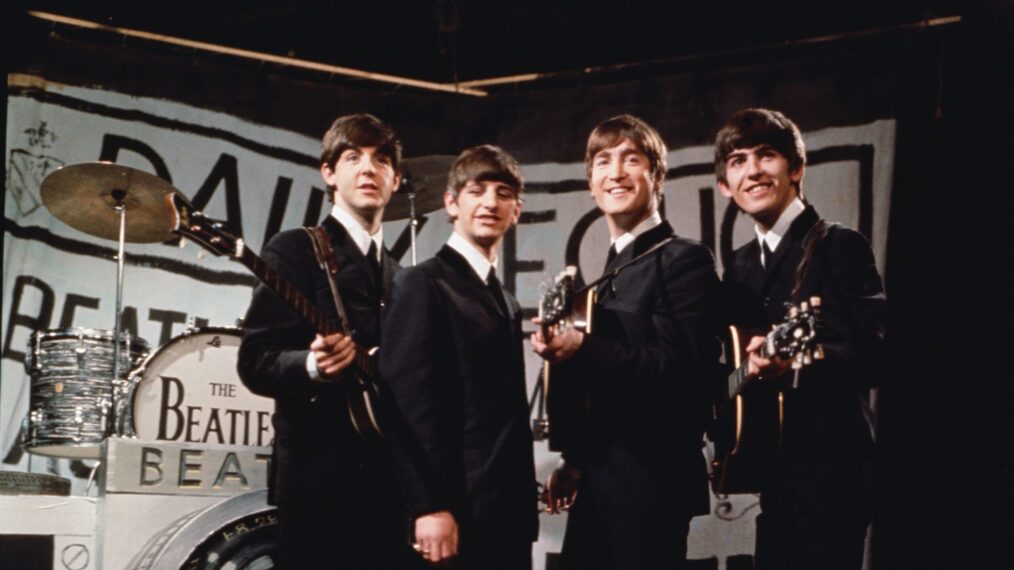10 Events That Secured 1950s Rock ‘N’ Roll Spot In Entertainment History
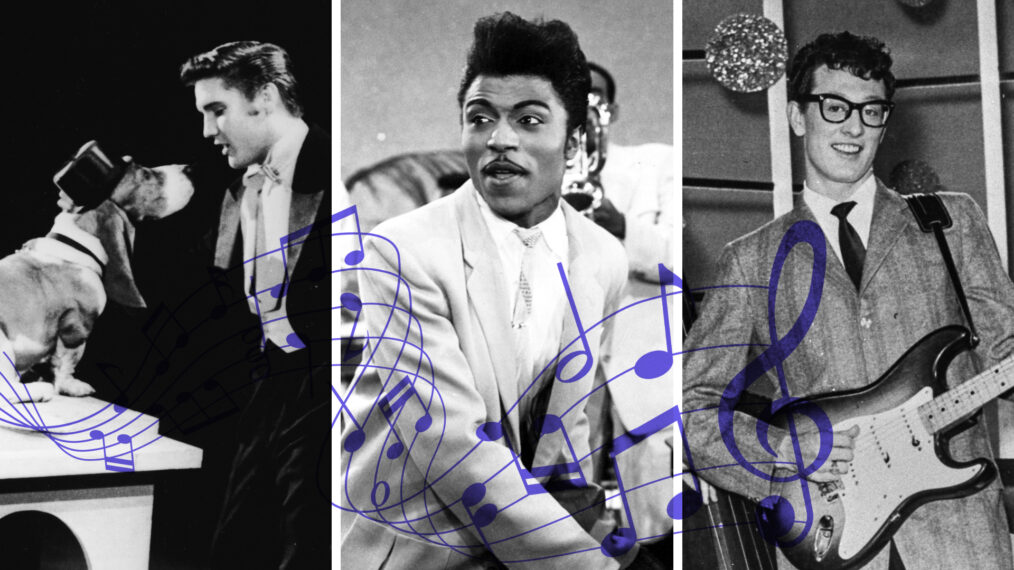
Right from the start, rock ’n’ roll had that lure you could not ignore. Forged innocently from a mix of blues, gospel, country and jazz, it seemed inoffensive enough … then rhythm and blues, boogie-woogie, jump blues and western swing got a hold of that sound, and suddenly, you had to move to it. Those young hepcats could no longer sit still.
But it didn’t happen overnight, and while lots of songs, performances and movies played a part, the 10 events below were seismic shifts that brought rock from its seminal days to its defining place deep in the hearts of fans the world over.
Jackie Brenston and his Delta Cats record “Rocket 88”
Early March 1951:
On a cool night in Memphis in 1951, an amplifier tumbles off the back of a truck heading down Highway 61. Members of the Delta Cats — actually, Ike Turner’s Kings of Rhythm, with Jackie Brenston along to do the vocals — nervously get out to retrieve their goods and then race to Memphis Recording Studio (later christened Sun Records), where producer Sam Phillips stuffs the amp’s broken speaker cone with a wad of newspapers. That’s the story they tell, anyway; but those newspapers gave guitarist Willie Kizart’s sound a wonderfully distorted buzz. There’d been other hip hits with a link to the start of rock — like Big Mama Thornton’s “Hound Dog” and Sister Rosetta Tharpe’s 1938 classic “Rock Me.” But “Rocket 88,” a tribute to ladies, liquor and a loaded Oldsmobile (pretty much lifted from a song called “Cadillac Boogie”), hit all the right notes, especially the fuzzy ones. As Turner later put it, “I don’t think ‘Rocket 88’ is rock ’n’ roll. I think that ‘Rocket 88’ is the cause of rock ’n’ roll existing.”
Alan Freed hosts the first major rock concert, the Moondog Coronation Ball
March 21, 1952
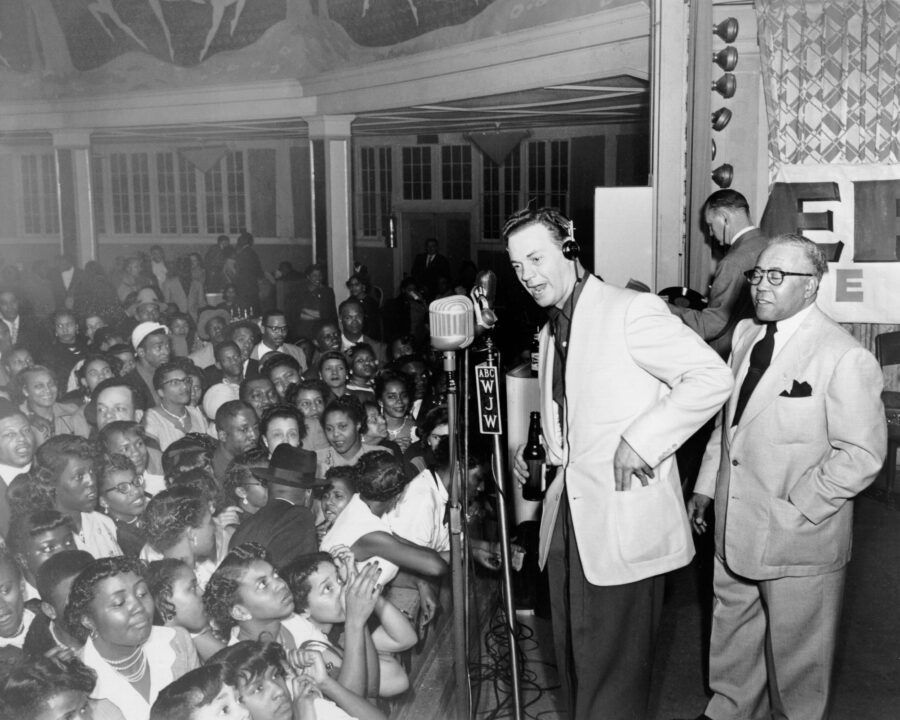
Michael Ochs Archives/Getty Images
The kids were so fired up, the crowd was so big and the music so good that the cops came in and shut it all down before it was over. No surprise there — Alan Freed, the first deejay who played this bopping new sound in America, had whipped them all into a frenzy. He loved the term “rock and roll,” an obscure phrase lifted from Billboard magazine, and he was noted for being a staunch believer in playing original R&B music by Black artists, instead of cover versions by white ones. Freed’s great popularity on Cleveland’s WJW-AM radio led to this concert — now regarded as the premier rock show — and the reaction only improved his reputation and the craze aspect of rock.
Elvis does his signature dance moves for the first time
Late July 1954:
Here’s the least surprising thing imaginable: During an early-career tour with country star Hank Snow, Elvis Presley invited female fans backstage after his performances and proceeded to have his shirt ripped off on several occasions. Earlier, on July 19, 1954, Sun Records had released his debut, a version of Arthur Crudup’s song “That’s All Right.” The 18-year-old ex-truck driver found himself conquering on a local level as well during that tour. Unable to control his nervous energy, he shook his legs to the rhythm of guitarist Scotty Moore and bassist Bill Black. In time, you wouldn’t see the name Elvis without mention of his pelvis, which made the world safe to dance to rock ’n’ roll.
Chuck Berry records “Maybellene”
May 21, 1955
Bob Wills and his Texas Playboys recorded their western swing hit “Ida Red” in 1938; some 17 years later, Chuck Berry, an auto assembly plant worker turned swift fingered guitarist, still enjoyed playing it at what he liked to call “salt and pepper clubs,” aka integrated establishments. And after blues legend Muddy Waters suggested he contact Leonard Chess at Chess Records, Berry brought in “Ida Red” as a possible single; Chess wanted something a little richer, with lyrics about fast cars and just-as-fast women. Who came up with the name? Was it Chess (claiming he saw a Maybelline mascara box on the floor of the studio) or Berry (remembering a name from a third-grade reader)? No matter: The fat sound of his Gibson ES-350T and riffs he borrowed from blues master T-Bone Walker became part of rock history as Berry “caught Maybellene at the top of the hill.”
Little Richard records “Tutti Frutti”
Sept. 14, 1955
“A-wop-bop-a-loo-mop-a-lop-bam-boom!” Nearly 70 years later, that opening refrain still gives the shivers. How did it happen? “Little” Richard Penniman was getting frustrated during a long recording session at Specialty Records, hoping for a hit. On a lunch break at the Dew Drop inn he began singing a mighty suggestive song he’d long ago penned, with the opening line, “A-wop-bop-a-loo-mop a-good goddamn!/Tutti Frutti, good booty.” Knowing a hit in the making when he heard one, producer Robert Blackwell brought songwriter Dorothy LaBostrie in to provide somewhat cleaner lyrics. The rest of it — the muscle, the influence, the volume … the beat — was all Richard. And it changed everything.
The film Rock Around the Clock premieres in theaters
March 21, 1956
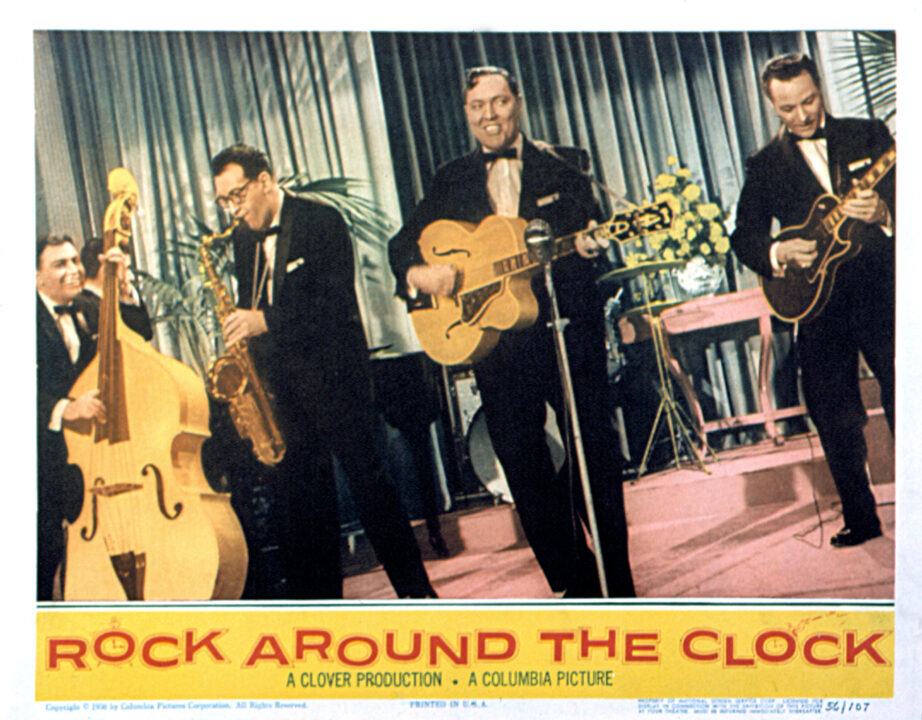
Everett Collection
It’s a safe bet that no song truly brought rock ’n’ roll to the mainstream before Bill Haley & His Comets recorded this bopping tune on April 12, 1954. But the tune’s appearance in the 1955 disaffected teen drama Blackboard Jungle cemented its place. After that, B-movie impresario Sam Katzman put together a 77-minute ridiculously plotted tale about the “discovery” of rock ’n’ roll music, almost suggesting the Haley and his band were the prime movers. The film starred Haley, Alan Freed, the Platters and other combos, with Haley and the boys singing all or part of nine songs. But that signature tune — which was almost called “Dance Around the Clock” by its songwriters — proved that rock could sell to audiences. Eight months later, in November 1956, Elvis Presley starred in his debut movie, Love Me Tender.
Million Dollar Quartet record at Sun Records
Dec. 4, 1956
Somehow, fate had one fantastic foursome convene together on a winter’s day at Sun Records. Carl Perkins, who’d had a hit with “Blue Suede Shoes,” was there to record new material. Sun Records founder Sam Phillips brought in a relatively unknown wild man named Jerry Lee Lewis — two months before he recorded the song “Whole Lotta Shakin’ Goin’ On” — to punch up the piano sound for Perkins’ record. Rising country singer Johnny Cash showed up to see Perkins play. And Elvis Presley, who’d left Sun for RCA, dropped by for a visit. Somehow, they ended up in a room together, playing mainly gospel songs from their youth, but really jamming on Chuck Berry’s “Brown Eyed Handsome Man.” An engineer had the presence of mind to push “record” in the studio. It took 25 years for it all to see the light of day, but it was worth the wait as a captured moment of rock’s present and future.
Link Wray plays “Rumble” live for the first time
January 1958
Only one instrumental song has ever been banned by radio stations in the U.S. and around the world. That honor goes to “Rumble,” kept off the air as much for its name (which suggested street fights) as for its sound … which was nasty. Rock was a little sanitized by 1958, but “Rumble” brought the nasty. Link Wray & His Wray Men were headlining a teen “hop” in Fredricksburg, Virginia, and the host suggested Wray do a version of “The Stroll,” a popular hit at the time. Wray had never heard the song but following on his brother’s insistent strolling beat on the drums, he began strumming mean-sounding power chords out of his poor-quality amp. When a microphone was put against that amp, the kids at the hop went wild, and Link had to play the thing over and over. Later on, to capture that beautifully ugly sound in the studio, Link stabbed holes in the amp’s tweeters with a pen. Jimmy Page celebrated it recently at the Rock & Roll Hall of Fame induction ceremony because, 66 years later, its power rumbles on.
Last concert for Buddy Holly, Ritchie Valens and the Big Bopper
Feb. 2, 1959
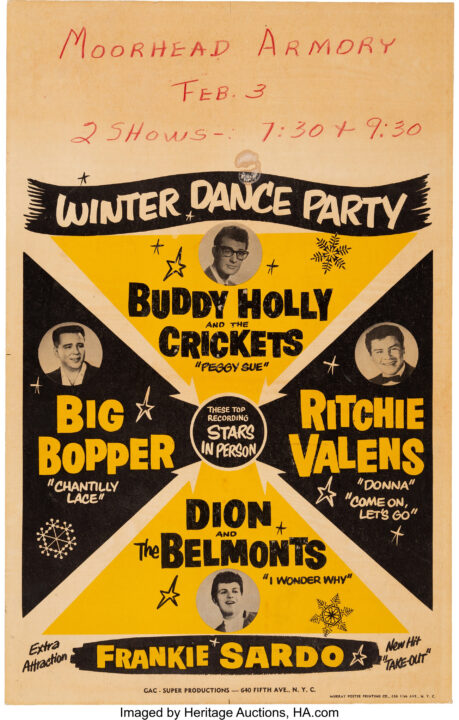
Early on the morning of Feb. 3, 1959, Buddy Holly, Ritchie Valens and J.P. “The Big Bopper” Richardson perished in a plane crash in Iowa. That event has been memorialized as “The Day the Music Died.” But just imagine what it must have been like to see these blistering, magical players the night before, at their last performance at the Surf Ballroom in Clear Lake, Iowa, part of a Winter Dance Party Tour. In his painfully short career, Holly — one of rock’s biggest-ever influences — recorded an astonishing list of singles including “That’ll Be the Day,” “Peggy Sue,” “Oh, Boy!” “Not Fade Away,” “Maybe Baby,” “Rave On” and “It’s So Easy.” Valens was a rising star with “La Bamba” and Richardson’s “Chantilly Lace” had come out months prior. No single event is more associated with rock’s propensity for tragedy, but it was the loss of Holly — a pioneer of the two-guitar rock sound — that’s felt most deeply, as suggested by Don McLean’s hit about the event, “American Pie.”
The Beatles appear on The Ed Sullivan Show for the first time
Feb. 9, 1964
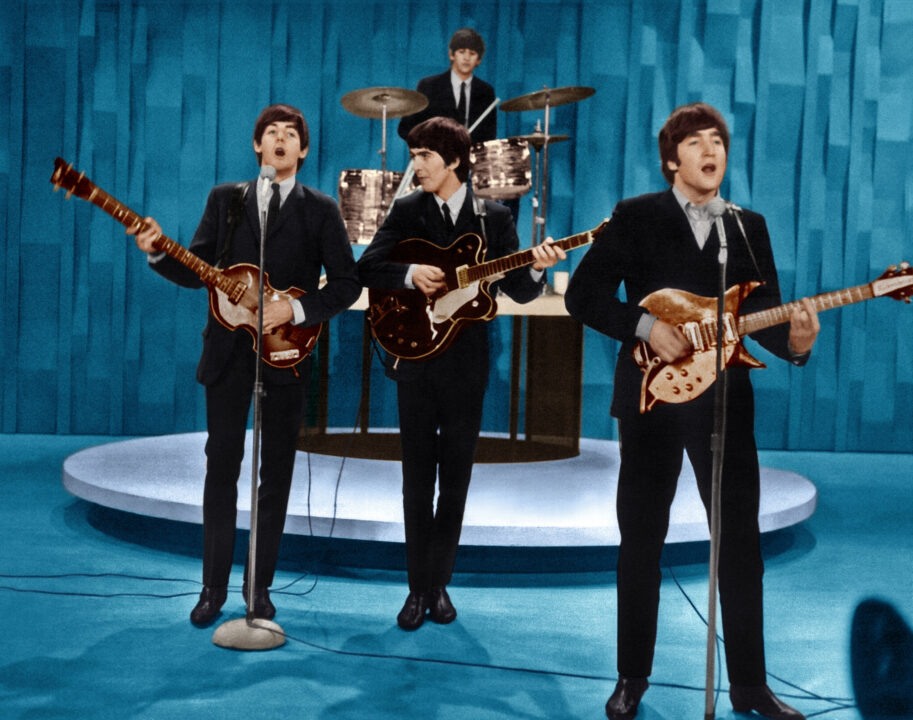
Why does the Beatles’ first appearance on Ed Sullivan’s popular variety show belong on any list of early rock influence? Because no single event brought the spirit of this music to mainstream America more effectively than John, Paul, George and Ringo’s five-song performance, which drew over 73 million viewers to their TV sets. And lots of those viewers became musicians because of it. “I remember exactly where I was sitting. It was like the axis shifted,” said Chrissie Hynde of the Pretenders. “Seeing the Beatles on Ed Sullivan was the beginning,” Cheap Trick’s Rick Nielsen said. And as Gene Simmons of Kiss put it, “There is no way I’d be doing what I do now if it wasn’t for the Beatles. I was watching The Ed Sullivan Show and … it blew me away.”
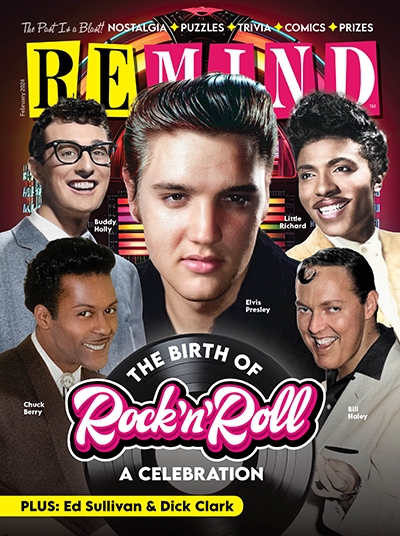
Birth of Rock 'n' Roll
February 2024
"Long live rock," we like to say, but how did it come to life? Revisit the memorable moments, music and movies that made teens go beat crazy back in the 1950s.
Buy This Issue
